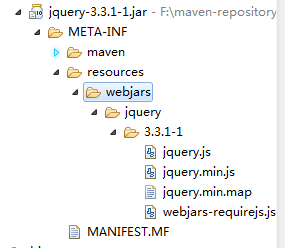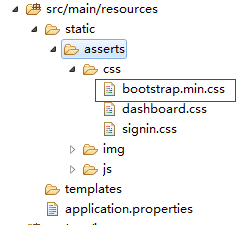版权声明:本文为博主原创文章,未经博主允许不得转载。 https://blog.csdn.net/wu2374633583/article/details/83963760
首先配置规则的映射源码是如下这个类:
WebMvcAutoConfiguration
@Override
public void addResourceHandlers(ResourceHandlerRegistry registry) {
if (!this.resourceProperties.isAddMappings()) {
logger.debug("Default resource handling disabled");
return;
}
Duration cachePeriod = this.resourceProperties.getCache().getPeriod();
CacheControl cacheControl = this.resourceProperties.getCache()
.getCachecontrol().toHttpCacheControl();
//webjars的映射
if (!registry.hasMappingForPattern("/webjars/**")) {
customizeResourceHandlerRegistration(registry
.addResourceHandler("/webjars/**")
.addResourceLocations("classpath:/META-INF/resources/webjars/")
.setCachePeriod(getSeconds(cachePeriod))
.setCacheControl(cacheControl));
}
//静态资源文件夹映射
String staticPathPattern = this.mvcProperties.getStaticPathPattern();
if (!registry.hasMappingForPattern(staticPathPattern)) {
customizeResourceHandlerRegistration(
registry.addResourceHandler(staticPathPattern)
.addResourceLocations(getResourceLocations(
this.resourceProperties.getStaticLocations()))
.setCachePeriod(getSeconds(cachePeriod))
.setCacheControl(cacheControl));
}
}
如果想在配置文件里面配置静态资源的参数的话:
@ConfigurationProperties(prefix = "spring.resources", ignoreUnknownFields = false)
public class ResourceProperties {
1 webjars的映射
webjars:以jar包的方式引入静态资源;
常用静态资源文件的webjars: https://www.webjars.org/
映射规则:
所有 /webjars/** ,都去 classpath:/META-INF/resources/webjars/ 找资源;
<dependency>
<groupId>org.webjars</groupId>
<artifactId>jquery</artifactId>
<version>3.3.1-1</version>
</dependency>

访问路径:
http://127.0.0.1:8080/webjars/jquery/3.3.1-1/jquery.js
2 静态资源文件夹的映射规则
有时候我们需要去映射自定义的静态资源,那么我们就需要知道springboot它是怎么来映射我们的资源文件和我们的文件应该怎么放。
规则如下:
“/**” 访问当前项目的任何资源,都去(静态资源的文件夹)找映射:
"classpath:/META‐INF/resources/",
"classpath:/resources/",
"classpath:/static/",
"classpath:/public/"
"/":当前项目的根路径
注意这里所说的classpath指的是:src/main/resources
比如:

访问路径为:
http://127.0.0.1:8080/asserts/css/bootstrap.min.css
3 欢迎页的配置
源码:
@Bean
public WelcomePageHandlerMapping welcomePageHandlerMapping(
ApplicationContext applicationContext) {
return new WelcomePageHandlerMapping(
new TemplateAvailabilityProviders(applicationContext),
applicationContext, getWelcomePage(),
this.mvcProperties.getStaticPathPattern());
}
private Optional<Resource> getWelcomePage() {
String[] locations = getResourceLocations(
this.resourceProperties.getStaticLocations());
return Arrays.stream(locations).map(this::getIndexHtml)
.filter(this::isReadable).findFirst();
}
private static final String[] CLASSPATH_RESOURCE_LOCATIONS = {
"classpath:/META-INF/resources/", "classpath:/resources/",
"classpath:/static/", "classpath:/public/" };
可以根据源码看到静态资源文件夹下的所有index.html页面;被"/**"映射;
localhost:8080/ 找index页面
4 小图标的映射
源码如下:
@Bean
public SimpleUrlHandlerMapping faviconHandlerMapping() {
SimpleUrlHandlerMapping mapping = new SimpleUrlHandlerMapping();
mapping.setOrder(Ordered.HIGHEST_PRECEDENCE + 1);
mapping.setUrlMap(Collections.singletonMap("**/favicon.ico",
faviconRequestHandler()));
return mapping;
}
所有的 **/favicon.ico 都是在静态资源文件下找;